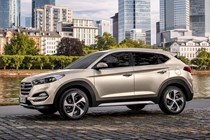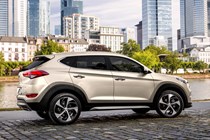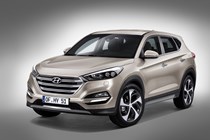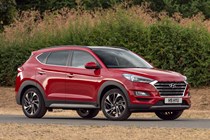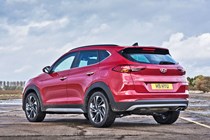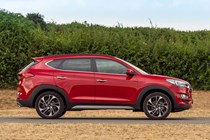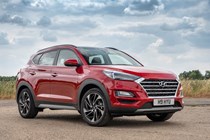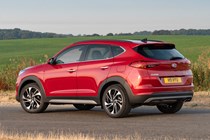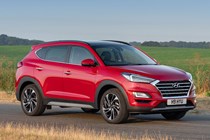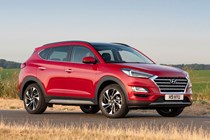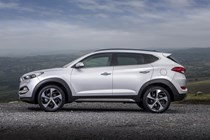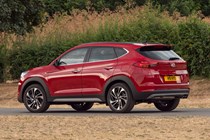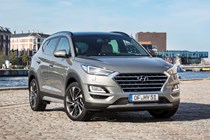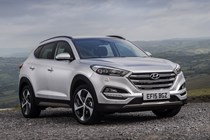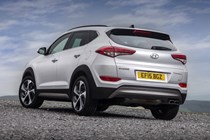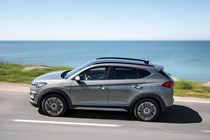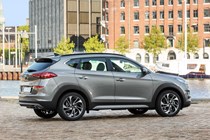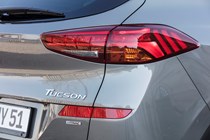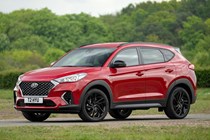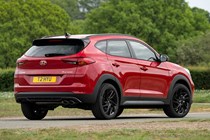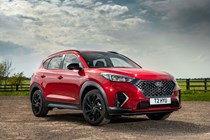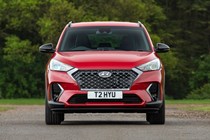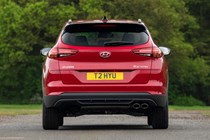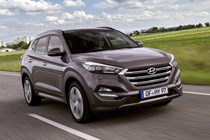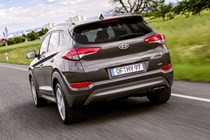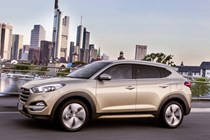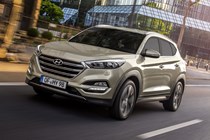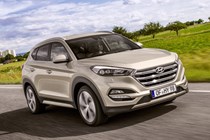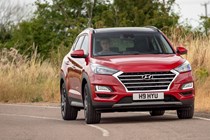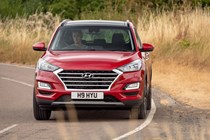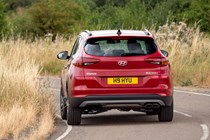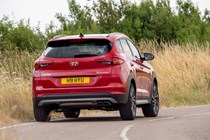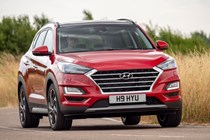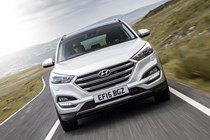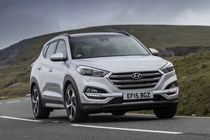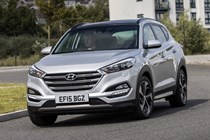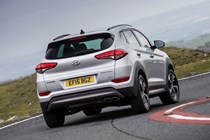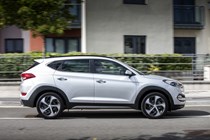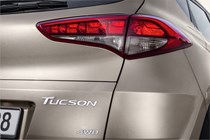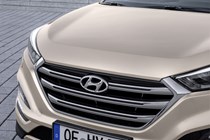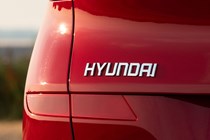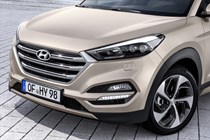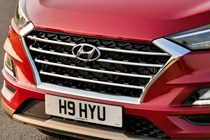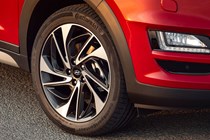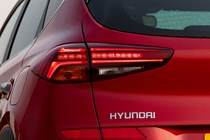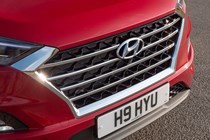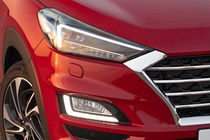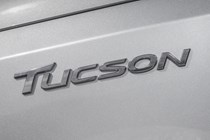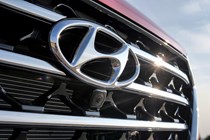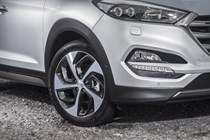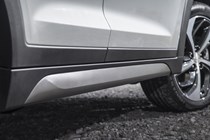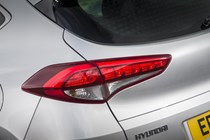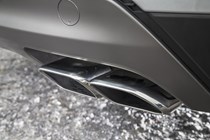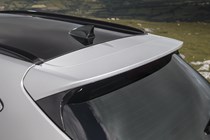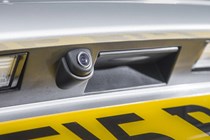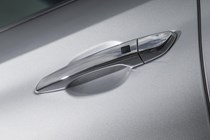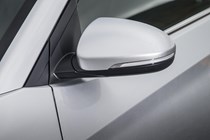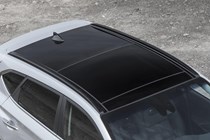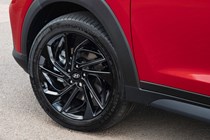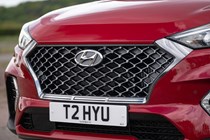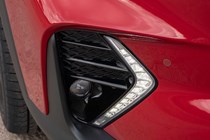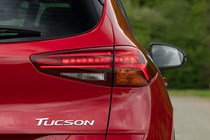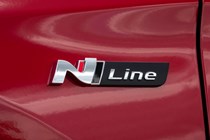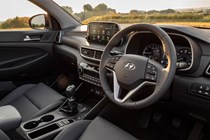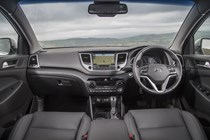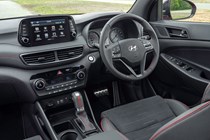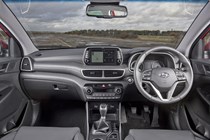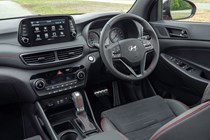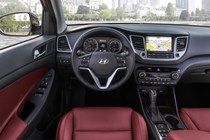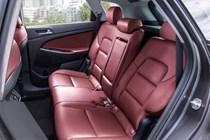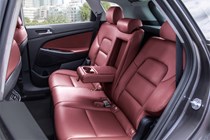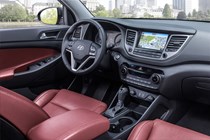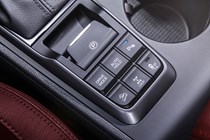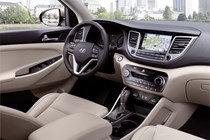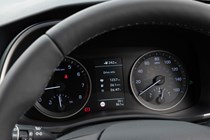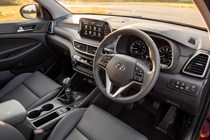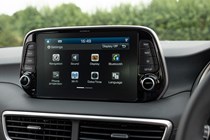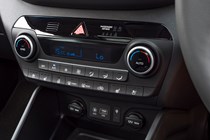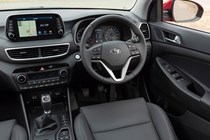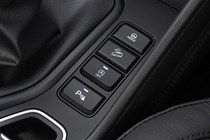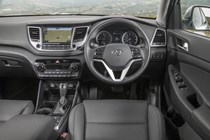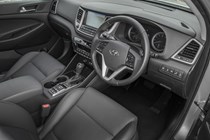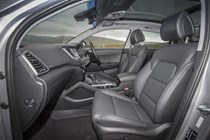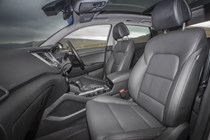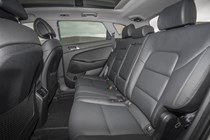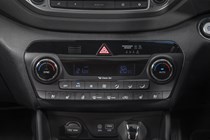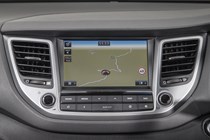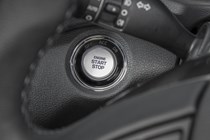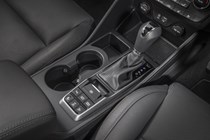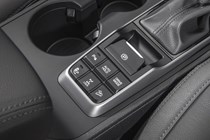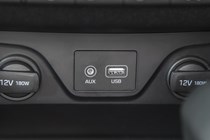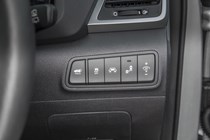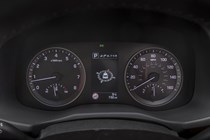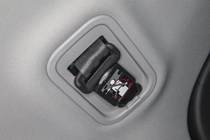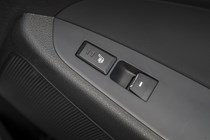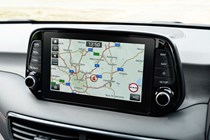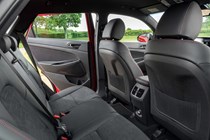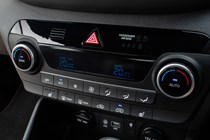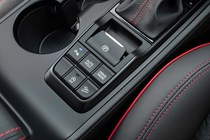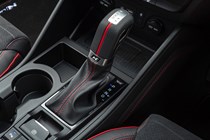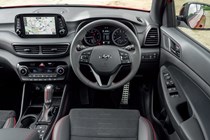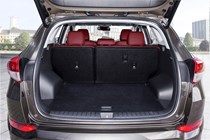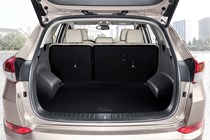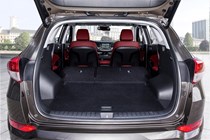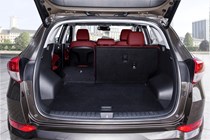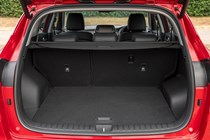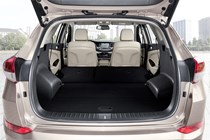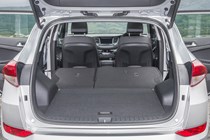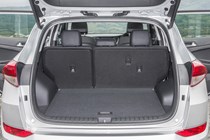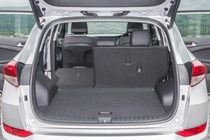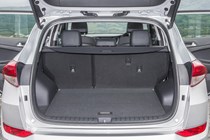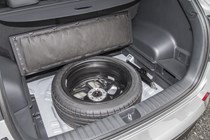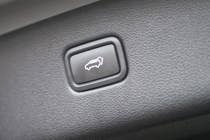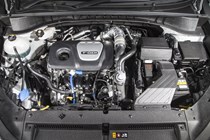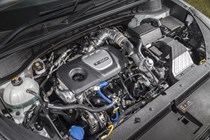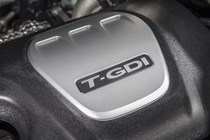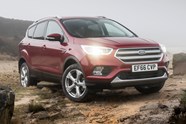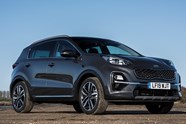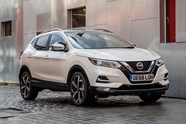
Hyundai Tucson Estate (2015-2020) review
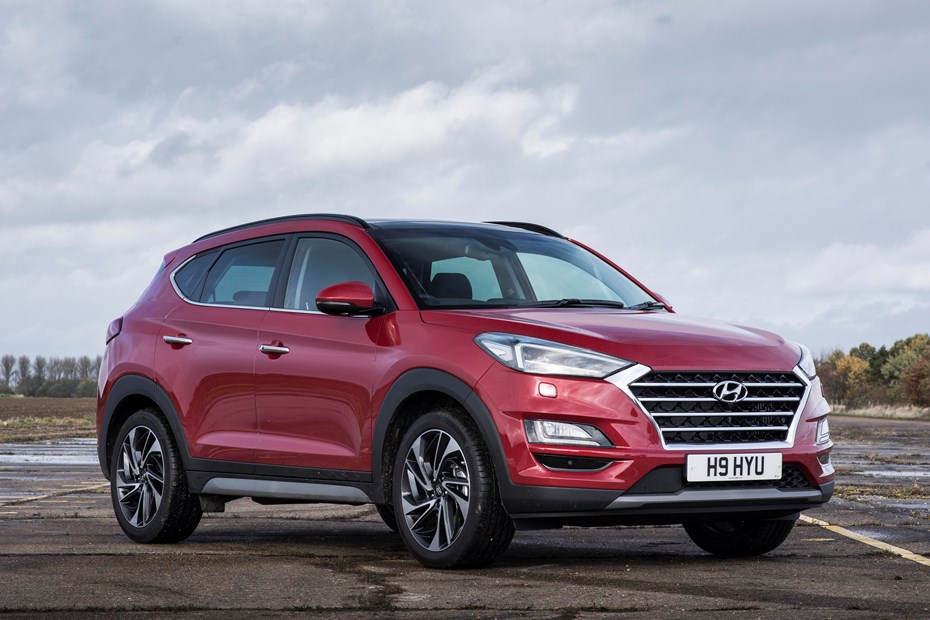
At a glance
| Price new | £19,955 - £35,320 |
|---|---|
| Used prices | £4,880 - £21,919 |
| Road tax cost | £35 - £345 |
| Insurance group | 12 - 25 |
Get an insurance quote with

|
|
| Fuel economy | 34.9 - 54.3 mpg |
| Range | 477 - 886 miles |
| Miles per pound | 5.1 - 6.9 |
| Number of doors | 5 |
| View full specs for a specific version | |
Available fuel types
Petrol
Diesel
Hybrid
Pros & cons
- Stylish details, handsome design
- Comfortable ride quality
- Impressive reliability record
- Petrol choices make less sense
- Several rivals are more practical
- Cabin doesn’t feel that special
Hyundai Tucson (15-20) rivals
Overview
For buyers taking a sensible approach to choosing their next used car, the third – ‘TL’ – generation of Hyundai Tucson should be on the SUV shortlist. Essentially a deep facelift of the Hyundai ix35, it features more conventional styling than the smaller Hyundai Kona, and is easier to park than the seven-seat Santa Fe. As a five-seater family car it’s spacious and practical – but it looks dated among this era’s new wave of medium-sized SUVs.
This is particularly apparent when you consider the striking fourth generation Tucson. Launched in 2021, it looks a prop from a sci-fi movie – and makes the 2015-20 Tucson we’re looking at in this guide seem older than it is.
Early 2021 Tucson Mk4s for sale look like better value than the top end of Tucson Mk3s, and used SUV buyers will also find that the budget needed for the most expensive 2015-2020 Tucson can easily buy second hand examples of premium SUVs that cost far more new, such as the Volvo XC40, BMW X1 and Land Rover Discovery Sport or Range Rover Evoque.
So does a used Hyundai Tucson Mk3 really represent good value for money? Its natural competitors new were the Volkswagen Tiguan, Mazda CX-5, Peugeot 3008/Citroen C5 Aircross, the technically similar Kia Sportage, and the Nissan Qashqai – nearly all of which cost less to buy for the same condition and mileage.
Used Hyundai Tucson Mk3 (2015-20) buying guide
We’ll start with some good news – the ‘TL’ generation of Hyundai Tucson meets Euro 6 in all versions and is clean air zone and ULEZ compliant as a diesel. Pre-April 2017 models get cheap road tax (VED) as well. It’s a good choice of used car if you want a lot of boot space (513 litres – though that’s only on non-hybrid base models without spare wheels) and a rear seat space large enough for older kids and adults to travel comfortably in. It’s less flexible than some rivals, offering two Isofix locations (no front or centre rear seat) and just the usual 60:40 split rear seat.
Which 2015-20 Hyundai Tucsons are AWD?
As with the Kia Sportage, all-wheel drive (or 4x4) Hyundai Tucsons in the UK are limited to the largest engine and high-spec trim. They use the Dynamax AWD system, which progressively engages the rear wheels, and includes hill descent control and a centre diff lock mode. It’s predictable and reliable, but not quite as efficient or involving as Haldex-equipped rivals. It’s also very sensitive to tyre differences.
Pre-2018 there is a choice of 136hp or 185hp 2.0-litre diesel with either six-speed manual or six-speed automatic gearbox, in SE Nav, Premium or Premium SE trim. For facelifted 2018-on models just one AWD version is offered, the 185hp 2.0 CRDi 48V Mild Hybrid with eight-speed automatic.
Which Hyundai Tucson is best for towing?
When buying a used Hyundai for towing, it’s worth noting that not all models in the range are equal. The maximum towing capacity of the 2015-20 Hyundai Tucson is 1,400kg – 2,200kg, but the highest 2,200kg applies only to pre-2018 2.0 CRDi models with manual gearboxes. Automatic models are limited to 1,900kg, dual-clutch seven-speed versions 1,600kg. The least powerful Tucson can tow 1,400kg.
Recommended: Hyundai Tucson 136-141hp CRDi SE Nav DCT
While the Tucson range has generous equipment levels overall, with a good selection of paint colours and on higher specifications, a choice of interior trims, the mid-range SE Nav is a good compromise. The seven-speed dual-clutch automatic is efficient and gets the best out of the mid-range, two-wheel drive diesel – 141hp 1.7-litre pre-2018, 1.6-litre with 136hp in facelift models. These are the most economical without feeling underpowered for long trips or when fully-laden.
Avoid: GDi and T-GDi petrol Tucson
Perhaps avoid is a strong term, but since the diesel range has proven reliability (not always the the case for this generation of cars overall) and does not attract emissions-based penalties for cities, it’s hard to think of a reason to choose the rather gutless 132hp petrol or the thirsty 177hp turbocharged T-GDi.
Hyundai Tucson ‘TL’ 2015-20 common problems
We like to feature 10 points for used car buyers to watch out for, and reassuringly the Hyundai Tucson was a real challenge. This is reflected by your feedback – our owners’ reviews are generally good, and the few low ratings received invariably relate to poor dealer experiences or the lack of performance from the 115hp version. Buy an approved-used model from a dealer with a good reputation, and we’re confident it will be a good experience.
1. Clutch wear on manual Hyundai Tucson models
The Hyundai Tucson is a heavy car with controls tuned for ease of use rather than feedback, so it’s not a surprise that the clutch wears out faster than many owners expect. Feel for juddering when pulling away, and listen for rising revs without an increase in speed in a high gear on hills. On petrol cars with a convention handbrake you can also try stalling the engine from idle – but we don’t recommend this test for diesel or electronic handbrake models.
On the test drive, change from second to fourth gear at around 25mph and accelerate when you have fully released the clutch pedal. It should be smooth but slow. Any clunking or vibration can indicate wear or damage to the dual-mass flywheel.
2. AdBlue system on post-2018 diesel models
Want to avoid AdBlue? Go for the pre-2018 diesel models. On models equipped with the emissions-reducing technology check that the AdBlue level display on the dashboard is working, and plug in a handheld diagnostic reader to check for fault codes. So far there are no consistent failures to watch out for on the TL-series Tucson with AdBlue, but we’d avoid any car that is showing fault codes for the emission system if it’s outside of an approved-used warranty scheme.
3. Diesel particulate filter – 1.7, 1.6 and 2.0 CRDi including hybrid models
All diesel Tucsons include a DPF, or diesel particulate filter. This stores soot (particulates) from the exhaust in normal operation and periodically regenerates – or in less eco-friendly terms, burns the soot out of the filter – when the car is travelling at higher speeds and has reached full operating temperature.
This means low mileage cars that have a higher chance of being driven for short, cold-start trips frequently with few opportunities to clear the filter can suffer from issues with blocked/restricted exhaust, excess fuel dumped into the engine oil, and increased wear on engine parts as a result. We’d favour cars with average mileage and a comprehensive service history over the traditional low-mileage used car preference – particularly if you’re looking at an automatic model where the risk of premature clutch wear is reduced.
4. Automatic gearbox – six-speed
This is a traditional automatic gearbox, but like many of this era it’s ‘sealed for life’ and has no dipstick. This means on cars with over 60,000 miles you will want to look for evidence of inspections or fluid changes in the service history. If you are able to get a vehicle inspection then the ATF (automatic transmission fluid) should be red and translucent when checked. If it is brown it needs replacement, if it smells burnt or has particles in it the gearbox may be due a rebuild, and if it is cloudy there may be a coolant leak contaminating the gearbox. ATF changes are recommended at 80,000 miles for heavy-duty use such as towing, but we’d plan for a fluid change at 60,000 mile intervals at the very least.
Check the oil cooler lines for corrosion and signs of leaking or damage. On the test drive, you should expect smooth, quick changes and no vibration or juddering, responsive overtaking, and no flaring or ‘slip’. Don’t be concerned if the gearbox is slow to respond in a junction or roundabout situation, however – it is designed to accommodate the stop-start system and also limit the risk of damage from harsh acceleration.
5. Seven-speed DCT gearbox – dual clutch automatic
In terms of efficiency and general driving behaviour, the DCT auto and mid-range diesel is a good combination. However, the Tucson experienced issues early on, leading to a recall programme in some countries, a new software update for the ECU, and some service actions. Most used Tucsons with this gearbox should be new enough to have a full Hyundai service history and have been maintained properly, but if the test drive shows any signs of slipping when moving away, clunky/sharp shifts, or unexpected behaviour when manually changing gear we’d walk away.
There is a dual-mass flywheel in this design, so feel for vibration at cruising speeds and listen for any loud noises when pulling away. The DCT gearbox should be serviced around 60,000 miles. It is a dry-clutch design in the Tucson, and gearbox oil should not affect routine operation – any issues with the gearbox are more likely to be clutch wear, sensor, servo or ECU related and unlike a conventional automatic, unlikely to improve with just a fluid change.
6. GDi and T-GDi engines – poor economy, low power
Neither of the petrol options available in the Hyundai Tucson is particularly economical, but the direct injection design means carbon buildup on the inlet valves can be a problem at higher mileages, particularly if low quality oil is used or servicing has been neglected.
Checking for this involves removing parts of the intake and looking inside with an inspection camera – not all sellers will be comfortable with this, so we’d go by service history, general condition, and how the car feels to drive. The 1.6-litre GDi is slow, but should rev freely. Various remedies for carbon build up are offered, such as walnut blasting, but we would expect a dealer to clean excessive carbon buildup from the intake and breather systems before selling a car at this price point.
Neglected servicing could also impact the otherwise reliable timing chain used in these engines, so listen for a metallic rattle when starting the engine from cold and when it is idling.
7. All-wheel drive system – 4x4 Hyundai Tucson checks
2.0-litre Hyundai Tucsons are available with AWD. This system uses an electronically controlled clutch to drive the rear wheels when the front wheels slip or when the car’s stability control detects a need for additional grip, including clever features like sensing if the wipers are on. There’s a switch to lock four-wheel drive operation on poor surfaces.
Your first check, aside from a lack of warning messages on the dashboard or stored diagnostic codes, is to make sure all four tyres have even wear and are matched sizes all-round, and matched brand and pattern on opposite sides, at the very least. Ideally the wheels should be swapped front to rear every 6,000 miles for even wear, and tyres changed as matched sets of four – but potholes and punctures can mean owners could be tempted to replace just one.
More than 3.5mm difference in diameter will place stress on the AWD system and ultimately cause failure of a differential or coupling. ABS and level sensors can also cause problems with the AWD system. Finally, check that it has been serviced at 60,000 miles, and if there’s any sign of the car being driven in floods make sure the differential oil has been changed soon after.
You can check operation of the 4x4 system with the diff lock switch. It will feel heavy on a gentle corner at parking speeds. Disengage it as soon as you have verified the ‘drag’ of a locked centre diff – though to protect the transmission, the diff lock disengages over 25mph.
8. Towing equipment and accessories
Hyundai’s traditional market for SUVs and 4x4s means the Tucson brand is well-regarded by drivers who need a vehicle that can tow for leisure and hobbies. The 2.0-litre 136hp and 185hp CRDi manual models, including AWD versions, can tow up to 2,200kg but the automatic gearbox is limited to 1,900kg.
Even so, the lowest-rated 1,400kg maximum versions have some appeal for owners of lighter caravans, as the Tucson is a large, stable vehicle for such duties. We would avoid the 1.6 GDi petrol for anything more than a hobby trailer due to the low torque of that engine.
In addition to checking for clutch wear, make sure the towing bracket and mounts have not introduced rust or bodywork damage, and inspect the wiring. We’d avoid universal wiring systems due to the sophisticated electronics of the Tucson – lift the boot floor and look for loose wires and spliced joins to the lights, rather than neat cables and a CANbus module. 13-pin trailer sockets are part of the MOT test – look for advisories when checking the MOT history online.
9. Technology and gadgets – Premium and Premium SE
There’s a lot of equipment included on the higher-end Hyundai Tucson, including parking assistance, heated rear seats, and 360-degree parking cameras. Even the glovebox is air conditioned. Check everything works before accepting the car, and remember that when buying from a dealer your consumer rights allow a return for a full refund within 30 days if there is an undisclosed defect that isn’t reasonable wear for the age and mileage. While they might argue for a chance to fix the car, you don’t have to accept it – it’s better to avoid the hassle before buying by being thorough.
Pay particular attention to features such as blind-spot monitoring, adaptive cruise control, and automatic headlight dipping. These, and the lane-keeping assistance, rely on sensors and cameras around the car that can be damaged or need recalibration after bodywork repairs or windscreen replacement. The dual-LED lights on 2018-on Premium SE models are also very expensive to replace if damaged or faulty.
10. Hybrid models – 48V MHD (mild hybrid)
2018 2.0-litre feature 48V mild hybrid technology, paired with a new eight-speed automatic gearbox and boosted by a lithium-ion battery pack. As these cars age, the battery will need replacement. This is potentially a four-figure repair bill, though outside of warranty there will undoubtedly be aftermarket solutions much like the market for replacement laptop batteries.
Check that operation of the stop-start system is smooth and error-free, and open the windows at low speeds to listen for whirring or scraping sounds. The gearbox should be smooth and unobtrusive in operation – for servicing, we’d look for the same regime as the six-speed automatic, checking fluid at 60,000 miles and replacing at 80,000, and ensuring all cooler lines and electrical connections are in good condition.
The 2019 Tucson N-Line is available with 1.6 CRDi or 1.6 T-GDi mild hybrid technology, as either a manual or DCT automatic two-wheel drive model. These cars should still be available under approved-used schemes and extended warranty for a few years, so we’d go that route and avoid bargain-basement examples or private sales for now.
What’s the Hyundai Tucson like to live with?
Over the next few pages, we’ll review each aspect of the 2015-20 Hyundai Tucson, taking into account its practicality, comfort, fuel economy and performance. If you’re short on time, you can also skip to our verdict page to see if we recommend buying a used TL generation Hyundai Tucson.



